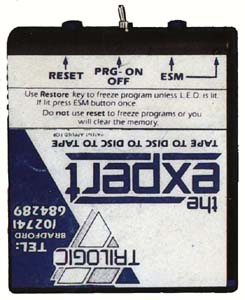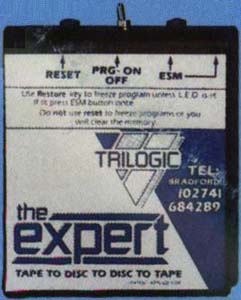

Scans from the cover of Trilogic's catalog. Note that the logo part of the label is upside down on the left image.
The Expert was manufactured by the company Trilogic. It is a freezer cartridge, with built-in machine code monitor, but no disk turbos or other basic wedges. A unique feature of the Expert is that the software is stored in RAM, which enables simple and cheap upgrades, but also requires the cartridge to be programmed from disk before it can be used.


Scans from the cover of Trilogic's catalog. Note that the logo part of
the label is upside down on the left image.
I have reverse engineered the schematics. Since the markings on the ICs were ground off, this involved desoldering some parts and analysing them on a breadboard. (Don't try this at home.)
------------
ESM + U6 --
| U5 U | C64
SWITCH + U4 7 | Edge
| U3 | connector
RESET + U2 U1 --
------------
U1:A and U1:C decode the address bus at $8000-$9FFF and $E000-$FFFF respectively. With the switch in the 'PRG' position, U3:B and U4:C enables the RAM at $8000. With the switch in the 'ON' position, U1:B enables the RAM at both $8000 and $E000, but only if the cartridge is active, that is, the flipflop formed by U3:C and U3:D is on. Writes are possible at $8000, by the help of U3:A and U2:A. (Note that the RAM won't respond to a write if the E1 input is high.)
The U3:C-U3:D flipflop controls if the cartridge is active or not. It is switched off by I/O1, i.e. an access to $DE00-$DEFF. It is switched on by either a RESET or an NMI when the ESM LED is not lit. I have not yet figured out exactly how the ESM circuitry works.
Software may come later.
Instead of using Trilogic's programming menu, I found it convenient to do a programming with the switch in its 'OFF' position, and save the memory from $8000-$9FFF to disk. Then to program the cartridge I would just put the switch at 'PRG' and load the memory image.